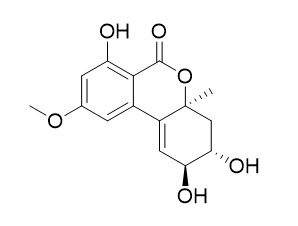Altenuene
Altenuene is a mycotoxin, it frequently occurs in food and feed items infested by fungi of the genus Alternaria. Altenuene demonstrates moderate activity against Staphylococcus aureus.
Altenuene also exhibits cytotoxic activity against lung cancer cell line A549, breast cancer cell line MDA-MB-231 and pancreatic cancer cell line PANC-1.
Inquire / Order:
manager@chemfaces.com
Technical Inquiries:
service@chemfaces.com
Tel:
+86-27-84237783
Fax:
+86-27-84254680
Address:
1 Building, No. 83, CheCheng Rd., Wuhan Economic and Technological Development Zone, Wuhan, Hubei 430056, PRC
Providing storage is as stated on the product vial and the vial is kept tightly sealed, the product can be stored for up to
24 months(2-8C).
Wherever possible, you should prepare and use solutions on the same day. However, if you need to make up stock solutions in advance, we recommend that you store the solution as aliquots in tightly sealed vials at -20C. Generally, these will be useable for up to two weeks. Before use, and prior to opening the vial we recommend that you allow your product to equilibrate to room temperature for at least 1 hour.
Need more advice on solubility, usage and handling? Please email to: service@chemfaces.com
The packaging of the product may have turned upside down during transportation, resulting in the natural compounds adhering to the neck or cap of the vial. take the vial out of its packaging and gently shake to let the compounds fall to the bottom of the vial. for liquid products, centrifuge at 200-500 RPM to gather the liquid at the bottom of the vial. try to avoid loss or contamination during handling.
Food and Fermentation Industries2018, 44(371)
Free Radic Biol Med.2016, 97:307-319
Pharmaceutics.2022, 14(12):2765.
Virol J.2024, 21(1):95.
J Cell Mol Med.2024, 28(16):e70015.
Molecules.2023, 28(13):4972.
J Biochem Mol Toxicol.2021, 35(5):e22731.
Journal of Third Military Medical University2018, 40(12):1073-1078
Antioxidants (Basel).2020, 9(11):1121.
Int J Pharm.2022, 618:121636.
Related and Featured Products
Fitoterapia. 2012 Jan;83(1):209-14.
Polyketides with antimicrobial activity from the solid culture of an endolichenic fungus Ulocladium sp.[Pubmed:
22061662 ]
METHODS AND RESULTS:
Two new polyketides, 7-hydroxy-3, 5-dimethyl-isochromen-1-one (1) and 6-hydroxy-8-methoxy-3a-methyl-3a,9b-dihydro-3H-furo[3,2-c]isochromene-2,5-dione (2), along with eleven known compounds, 5'-methoxy-6-methyl-biphenyl-3,4,3'-triol (3), 7-hydroxy-3-(2-hydroxy-propyl)-5-methyl-isochromen-1-one (4), rubralactone (5), isoAltenuene (6), Altenuene (7), dihydroAltenuenes A (8), altenusin (9), alterlactone (10), 6-O-methylnorlichexanthone (11), norlichexanthone (12), and griseoxanthone C (13) were isolated from the culture of the endolichenic fungus Ulocladium sp. Compound 2 was obtained as a racemate with an unprecedented chemical skeleton. The NMR data assignments for 3 and 4 were achieved for the first time. Compounds 1-13 were screened for their antimicrobial and radical scavenging activities.
CONCLUSIONS:
Compound 1 showed some antifungal activity against Candida albicans SC 5314 with IC(50) of 97.93 ± 1.12 μM. Compounds 11-13 showed strong activity against Bacillus subtilis with IC(50) in the range of 1-5 μM. Compound 12 significantly inhibited the growth of methicillin-resistant Staphylococcus aureus with IC(50) of 20.95 ± 1.56 μM. Compounds 9 and 10 showed strong radical scavenging activity in comparison with vitamin C. The plausible biosynthetic pathways for compounds 1, 2, and 4-8 were discussed.
Yao Xue Xue Bao. 2013 Jun;48(6):891-5.
A new sesquiterpenoid from fungus Colletotrichum sp. and its cytotoxicity.[Pubmed:
23984524]
METHODS AND RESULTS:
A novel sesquiterpenoid (1) and three known compounds identified as isoAltenuene (2), Altenuene (3), and alternariol 4, 10-O-dimethyl ether (4), were isolated in our investigation of the cytotoxic constituents from solid cultures of the endophytic fungus Colletotrichum sp. The structures of these compounds were elucidated through spectroscopic data analysis.
CONCLUSIONS:
All compounds exhibited cytotoxic activity against lung cancer cell line A549, breast cancer cell line MDA-MB-231 and pancreatic cancer cell line PANC-1. Compound 4 could induce the PANC-1 cells inflation or death, but couldn't induce apoptosis at the IC50 of 60.2 microg x mL(-1).
Mycotoxin Res. 2017 Nov;33(4):309-321.
Alternaria toxins in South African sunflower seeds: cooperative study.[Pubmed:
28755328 ]
METHODS AND RESULTS:
Sunflower seed samples (N02=0280) from different sunflower cultivars originating from different localities in South Africa were analyzed for 15 toxins produced by fungi of the genus Alternaria by means of a simple one-step extraction dilute-and-shoot HPLC-MS/MS approach. References for valine-tenuazonic acid (Val-TeA), altenusin (ALTS), and altenuisol (ALTSOH) were isolated from fungal culture extracts and spectroscopically characterized. Additionally, valine-tenuazonic acid was tested regarding its cytotoxicity in comparison with tenuazonic acid (TeA) and showed less activity on HT-29 cells. Furthermore, alternariol monomethyl ether-3-O-08-D-glucoside (AME-3G) was produced by fermentation of alternariol monomethyl ether (AME) with the fungus Rhizopus oryzae. The seed samples were analyzed both with and without hulls.
CONCLUSIONS:
The method covers the AAL toxins TA 1 and TA 2 , Altenuene (ALT) and iso-Altenuene (iso-ALT), altenuisol, altenusin, altertoxin I (ATX-I) and altertoxin II (ATX-II), alternariol (AOH) and alternariol monomethyl ether, alternariol monomethyl ether-3-O-08-D-glucoside, tenuazonic acid, allo-tenuazonic acid (allo-TeA) and valine-tenuazonic acid, and tentoxin (TEN).
Nat Prod Res. 2015;29(9):848-52.
A new alternariol glucoside from fungus Alternaria alternate cib-137.[Pubmed:
25520187 ]
METHODS AND RESULTS:
A new secondary metabolite, 2-O-methylalternariol 4-O-β-[4-methoxyl-glucopyranoside] (1), together with four known compounds alternariol methyl ether (2), Altenuene (3), isoAltenuene (4) and 2-(2'S-hydroxypropyl)-5-methyl-7-hydroxychromone (5), was isolated from the fungus Alternaria alternate cib-137.
CONCLUSIONS:
Its structure was elucidated on the basis of spectroscopic data. Compounds 3 and 4 demonstrated moderate activity against Staphylococcus aureus.



